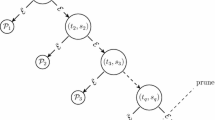Abstract
In this paper, we introduce a new class of algorithms for solving the mixed-integer bilevel min–max optimization problem. This problem involves two players, a leader and a follower, who play a Stackelberg game. In particular, the leader seeks to minimize over a set of discrete variables the maximum objective that the follower can achieve. The complicating features of our problem are that a subset of the follower’s decisions are restricted to be integer-valued, and that the follower’s decisions are constrained by the leader’s decisions. We first describe several bilevel min–max programs that can be used to obtain lower and upper bounds on the optimal objective value of the problem. We then present algorithms for this problem that finitely terminate with an optimal solution when the leader variables are restricted to take binary values. Finally, we report the results of a computational study aimed at evaluating the quality of our algorithms on two families of randomly generated problems.


Similar content being viewed by others
References
Ball, M.O., Golden, B.L., Vohra, R.V.: Finding the most vital arcs in a network. Oper. Res. Lett. 8(2), 73–76 (1989)
Bard, J.F., Moore, J.T.: An algorithm for the discrete bilevel programming problem. Nav. Res. Logist. 39(3), 419–435 (1992)
Bazaraa, M.S., Jarvis, J.J., Sherali, H.D.: Linear Programming and Network Flows, 3rd edn. Wiley, Hoboken (2005)
Bazaraa, M.S., Sherali, H.D., Shetty, C.M.: Nonlinear Programming: Theory and Algorithms, 3rd edn. Wiley, Hoboken (2006)
Beheshti, B., Özaltın, O.Y., Zare, M.H., Prokopyev, O.A.: Exact solution approach for a class of nonlinear bilevel knapsack problems. J. Glob. Optim. (2014). doi:10.1007/s10898-014-0189-8
Bialas, W.F., Karwan, M.H.: On two-level optimization. IEEE Trans. Autom. Control 27(1), 211–214 (1982)
Bialas, W.F., Karwan, M.H.: Two-level linear programming. Manag. Sci. 30(8), 1004–1021 (1984)
Brotcorne, L., Hanafi, S., Mansi, R.: A Dynamic programming algorithm for the Bilevel Knapsack Problem. Oper. Res. Lett. 37(3), 215–218 (2009). ISSN 0167–6377
Brotcorne, L., Hanafi, S., Mansi, R.: One-level reformulation of the bilevel knapsack problem using dynamic programming. Discrete Optim. 10(1), 1–10 (2013)
Brown, G.G., Carlyle, W.M., Salmerón, J., Wood, K.: Analyzing the vulnerability of critical infrastructure to attack and planning defenses. In: Greenberg, H.J., Smith, J.C. (eds.) Tutorials in Operations Research: Emerging Theory, Methods, and Applications, pp. 102–123. INFORMS, Hanover, MD (2005)
Candler, W., Townsley, R.: A linear two-level programming problem. Comput. Oper. Res. 9(1), 59–76 (1982)
Caprara, A., Carvalho, M., Lodi, A., Woeginger, G.J.: A complexity and approximability study of the bilevel knapsack problem. In: Goemans, M., Correa, J. (eds.) Integer Programming and Combinatorial Optimization, pp. 98–109. Springer, Berlin (2013)
Corley, H.W., Sha, D.Y.: Most vital links and nodes in weighted networks. Oper. Res. Lett. 1(4), 157–160 (1982)
Danskin, J.: The theory of max–min, with applications. SIAM J. Appl. Math. 14, 641–664 (1966)
Delgadillo, A., Arroyo, J.M., Alguacil, N.: Analysis of electric grid interdiction with line switching. IEEE Trans. Power Syst. 25(2), 633–641 (2010)
Dempe, S.: Foundations of Bilevel Programming. Kluwer Academic Publishers, Boston (2002)
Dempe, S., Richter, K.: Bilevel programming with knapsack constraints. CEJOR 8(2), 93–107 (2000)
DeNegre, S.T., Ralphs, T.K.: A branch-and-cut algorithm for integer bilevel linear programs. In: Chinneck, J.W., Kristjansson, B., Saltzman, M.J. (eds.) Operations Research and Cyber-Infrastructure, pp. 65–78. Springer, New York (2009)
Fulkerson, D.R., Harding, G.C.: Maximizing minimum source-sink path subject to a budget constraint. Math. Program. 13(1), 116–118 (1977)
Glover, F.: Improved linear integer programming formulations of nonlinear integer problems. Manag. Sci. 22(4), 455–469 (1975)
Glover, F., Woolsey, E.: Converting the 0–1 polynomial programming problem to a 0–1 linear program. Oper. Res. 22(1), 180–182 (1974)
Golden, B.: A problem in network interdiction. Nav. Res. Logist. Q. 25(4), 711–713 (1978)
Hansen, P., Jaumard, B., Savard, G.: New branch-and-bound rules for linear bilevel programming. SIAM J. Sci. Stat. Comput. 13(5), 1194–1217 (1992)
Israeli, E., Wood, R.K.: Shortest-path network interdiction. Networks 40(2), 97–111 (2002)
Lim, C., Smith, J.C.: Algorithms for discrete and continuous multicommodity flow network interdiction problems. IIE Trans. 39(1), 15–26 (2007)
Mahdavi Pajouh, F., Boginski, V., Pasiliao, E.L.: Minimum vertex blocker clique problem. Networks 64(1), 48–64 (2014)
Malaviya, A., Rainwater, C., Sharkey, T.C.: Multi-period network interdiction problems with applications to city-level drug enforcement. IIE Trans. 44(5), 368–380 (2012)
Malik, K., Mittal, A.K., Gupta, S.K.: The k most vital arcs in the shortest path problem. Oper. Res. Lett. 8(4), 223–227 (1989)
MIT Strategic Engineering Research Group. MATLAB tools for network analysis. http://strategic.mit.edu/docs/matlab_networks/random_graph.m. Accessed Oct 2013
Moore, J.T., Bard, J.F.: The mixed integer linear bilevel programming problem. Oper. Res. 38(5), 911–921 (1990)
Morton, D.P., Pan, F., Saeger, K.J.: Models for nuclear smuggling interdiction. IIE Trans. 39(1), 3–14 (2007)
Ratliff, H.D., Sicilia, G.T., Lubore, S.H.: Finding the n most vital links in flow networks. Manag. Sci. 21(5), 531–539 (1975)
Vazirani, V.V.: Approximation Algorithms. Springer, New York (2004)
Vicente, L.N., Savard, G., Judice, J.J.: Discrete linear bilevel programming problem. J. Optim. Theory Appl. 89, 597–614 (1996)
von Stackelberg, H.: The Theory of the Market Economy. William Hodge and Co., London (1952)
Ward, J.E., Wendell, R.E.: Approaches to sensitivity analysis in linear programming. Ann. Oper. Res. 27, 3–38 (1990)
Wets, R.J.-B.: On the continuity of the value of a linear program and of related polyhedral-value multifunctions. Math. Program. Study 24, 14–29 (1985)
Wollmer, R.D.: Removing arcs from a network. Oper. Res. 12(6), 934–940 (1964)
Wood, R.K.: Deterministic network interdiction. Math. Comput. Model. 17(2), 1–18 (1993)
Author information
Authors and Affiliations
Corresponding author
Additional information
The authors gratefully acknowledge an anonymous referee, whose remarks led to an improved presentation of our research. This work has been supported by the National Science Foundation through Grant CMMI-11000765, the Defense Threat Reduction Agency through Grant HDTRA1-10-1-0050, the Air Force Office of Scientific Research under Grant FA9550-12-1-0353, and the Office of Naval Research under grant N000141310036.
Rights and permissions
About this article
Cite this article
Tang, Y., Richard, JP.P. & Smith, J.C. A class of algorithms for mixed-integer bilevel min–max optimization. J Glob Optim 66, 225–262 (2016). https://doi.org/10.1007/s10898-015-0274-7
Received:
Accepted:
Published:
Issue Date:
DOI: https://doi.org/10.1007/s10898-015-0274-7




